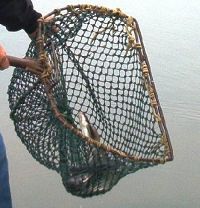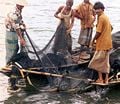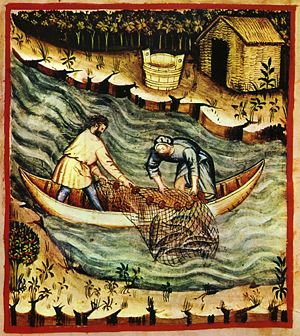Difference between revisions of "Fishing net" - New World Encyclopedia
m (Robot: Remove claimed tag) |
Keisuke Noda (talk | contribs) |
||
| Line 1: | Line 1: | ||
| − | + | {{fishing net topics}} | |
| − | + | [[Image:Net.gsfc.jpg|thumb|200px|left|A landing net]] | |
| − | {{ | + | A '''fishing net''' or '''fishnet''' is a [[Net (device)|net]] that is used for [[fishing]]. Fishing nets are [[mesh]]es usually formed by [[knot]]ting a relatively thin thread. Modern nets are usually made of artificial [[polyamide]]s like [[nylon]], although nets of organic polyamides such as [[wool]] or [[silk]] thread were common until recently and are still used. |
| − | ''' | ||
== Types of fishing nets == | == Types of fishing nets == | ||
| − | [[Image:Net | + | [[Image:Fishing_In_Orissa.JPG|thumb|right|Man using a cast net in Mahanadi River [[Orissa]], [[India]]]] |
| + | [[Image:Coracles River Teifi.jpg|thumb|right|Coracles on the [[River Teifi]], [[Wales]] 1972.]] | ||
| + | [[Image:Chinese Fishing Net (Kochi, India).jpg|thumb|right|Kochi fishing net]] | ||
| − | + | ====Hand net==== | |
| + | Hand nets are held open by a hoop and are possibly on the end of a long stiff handle. They have been known since antiquity and may be used for sweeping up fish near the water surface like [[muskellunge]] and [[northern pike]]. When such a net is used by an [[angler]] to help land a fish it is known as a ''landing net''.<ref name="Fishing Tools - Landing Nets">[http://www.abc-of-fishing.net/fishing-tools/landing-net.asp Fishing Tools - Landing Nets]</ref> In [[England]], hand netting is the only legal way of catching [[eel]]s and has been practised for thousands of years on the [[River Parrett]] and [[River Severn]]. | ||
| − | + | ====Cast net==== | |
| + | Cast nets are small round nets with weights on the edges which is thrown by the fisher. Sizes vary up to about four metres in diameter. The net is thrown by hand in such a manner that it spreads out on the water and sinks. Fish are caught as the net is hauled back in.<ref>[http://www.nccoastalfishing.com/index.htm?casting.htm~main Casting net].</ref> | ||
| − | [[Coracle| | + | ====Coracle fishing==== |
| + | [[Coracle|Coracle fishing]] is performed by two men, each seated in a coracle, plying his paddle with one hand and holding a shared net with the other. When a fish is caught, each hauls up his end of the net until the two coracles are brought to touch and the fish is secured. | ||
| − | The [[Chinese fishing nets (of Kochi)| | + | ====Chinese nets==== |
| + | The [[Chinese fishing nets (of Kochi)|Chinese fishing nets]] (Cheena vala) are used at [[Kochi, India|Kochi]] in India. They are an example of ''shore operated lift nets''<ref>[http://www.fao.org/figis/servlet/geartype?fid=255 Shore operated stationary lift nets]</ref> because they are held horizontally by a large fixed structure and periodically lowered into the water. Huge mechanical contrivances hold out horizontal nets with diameters of twenty metres or more. The nets are dipped into the water and raised again, but otherwise cannot be moved. | ||
| − | + | ====Gillnet==== | |
| + | The [[gillnet]] catches fish which try to pass through it by snagging on the gill covers. Thus trapped, the fish can neither advance through the net nor retreat. | ||
| − | + | ====Drift net==== | |
| − | [[ | + | The [[drift net]] is a net that is not anchored. It is usually a gillnet, and is commonly used in the coastal waters of many countries.<ref>[[Drift net]]</ref>. Its use on the high seas is prohibited, but still occurs. |
| − | + | ====Ghost net==== | |
| + | [[Ghost net]]s are nets that have been lost at sea. They may continue to be a menace to marine life for many years. | ||
| − | + | ====Stake net==== | |
| + | A stake net is a form of net for catching salmon. It consists of a sheet of network stretched on stakes fixed into the ground, generally in rivers or where the sea ebbs and flows, for entangling and catching the fish. | ||
| − | + | ====Trammel==== | |
| + | A trammel is a fishing net set vertically in the water with three layers. The inner layer is of a finer mesh than the outer layers. | ||
| − | + | ====Seine==== | |
| + | A [[Seine (fishing)|seine]] is a large fishing net that may be arranged in a number of different ways. In [[purse seine]] fishing the net hangs vertically in the water by attaching weights along the bottom edge and floats along the top. A simple and commonly used fishing technique is beach seining, where the seine net is operated from the shore. Danish seine is a method which has some similarities with trawling. | ||
| + | ====Trawl==== | ||
| + | A [[trawl]] is a large net, conical in shape, designed to be towed in the sea or along the sea bottom. The trawl is pulled through the water by one or more boats, called [[Commercial trawler|trawlers]]. The activity of pulling the trawl through the water is called trawling. | ||
<gallery> | <gallery> | ||
| − | |||
Image:BD-fishermen.jpg|Fishermen in [[Bangladesh]] | Image:BD-fishermen.jpg|Fishermen in [[Bangladesh]] | ||
Image:Fisherman mending net.jpg|A Moroccan fisherman mending his nets. | Image:Fisherman mending net.jpg|A Moroccan fisherman mending his nets. | ||
Image:Vissersboot(01).jpg|Fishing nets on a shrimp boat, [[Ostend]], [[Belgium]] | Image:Vissersboot(01).jpg|Fishing nets on a shrimp boat, [[Ostend]], [[Belgium]] | ||
| + | Image:Fishing.cropped.jpg|Fishing with a cast net. | ||
</gallery> | </gallery> | ||
| + | |||
| + | == History == | ||
| + | : ''See also: [[History of fishing]]'' | ||
| + | [[Image:36-pesca,Taccuino Sanitatis, Casanatense 4182..jpg|thumb|left|Fishing , [[tacuinum sanitatis]] casanatensis (XIV century)]] | ||
| + | Between 177 and 180 the Greek author [[Oppian]] wrote the ''Halieutica'', a didactic poem about fishing. He described various means of fishing including the use of nets cast from boats, scoop nets held open by a hoop, and various traps "which work while their masters sleep." Here is Oppian's description of fishing with a "motionless" net: | ||
| + | [[Image:Albrecht Dürer 107.jpg|thumb|right|[[Albrecht Dürer]] c. 1490-1493]] | ||
| + | : ''The fishers set up very light nets of buoyant flax and wheel in a circle round about while they violently strike the surface of the sea with their oars and make a din with sweeping blow of poles. At the flashing of the swift oars and the noise the fish bound in terror and rush into the bosom of the net which stands at rest, thinking it to be a shelter: foolish fishes which, frightened by a noise, enter the gates of doom. Then the fishers on either side hasten with the ropes to draw the net ashore.'' | ||
| + | |||
| + | Pictorial evidence of [[Ancient Rome|Roman]] fishing comes from [[mosaic]]s which show nets.<ref>[http://museum.agropolis.fr/english/pages/expos/aliments/poissons/images/mosaique.htm Image of fishing illustrated in a Roman mosaic].</ref> In a parody of fishing, a type of [[gladiator]] called [[retiarius]] was armed with a [[trident]] and a casting-net. He would fight against the [[murmillo]], who carried a short sword and a helmet with the image of a fish on the front. | ||
| + | |||
| + | In [[Norse mythology]] the sea giantess [[Rán]] uses a fishing net to trap lost sailors. | ||
== See also == | == See also == | ||
| Line 40: | Line 63: | ||
* [[Fishnet (material)]] | * [[Fishnet (material)]] | ||
| − | == | + | ==Notes== |
{{reflist}} | {{reflist}} | ||
| + | |||
| + | ==External links== | ||
| + | * [http://www.amcs.org.au/default2.asp?active_page_id=156 Fishing Gear in Focus] | ||
| + | |||
| + | |||
| + | |||
| + | {{fishing industry}} | ||
| + | {{recreational fishing}} | ||
[[Category:Fishing equipment]] | [[Category:Fishing equipment]] | ||
| − | + | {{credits|Fishing_net|221881547}} | |
| − | {{credits|Fishing_net| | ||
Revision as of 12:10, 9 July 2008
| fishing |
|---|
| fishing nets |
| gillnet |
| drift net |
| ghost net |
| surround net |
| chinese nets |
| lampuki netting |
| coracle fishing |
| glass floats |
| excluders |
| trawls |
| seine |
|
|
| techniques |
| tackle |
| recreational |
A fishing net or fishnet is a net that is used for fishing. Fishing nets are meshes usually formed by knotting a relatively thin thread. Modern nets are usually made of artificial polyamides like nylon, although nets of organic polyamides such as wool or silk thread were common until recently and are still used.
Types of fishing nets

Hand net
Hand nets are held open by a hoop and are possibly on the end of a long stiff handle. They have been known since antiquity and may be used for sweeping up fish near the water surface like muskellunge and northern pike. When such a net is used by an angler to help land a fish it is known as a landing net.[1] In England, hand netting is the only legal way of catching eels and has been practised for thousands of years on the River Parrett and River Severn.
Cast net
Cast nets are small round nets with weights on the edges which is thrown by the fisher. Sizes vary up to about four metres in diameter. The net is thrown by hand in such a manner that it spreads out on the water and sinks. Fish are caught as the net is hauled back in.[2]
Coracle fishing
Coracle fishing is performed by two men, each seated in a coracle, plying his paddle with one hand and holding a shared net with the other. When a fish is caught, each hauls up his end of the net until the two coracles are brought to touch and the fish is secured.
Chinese nets
The Chinese fishing nets (Cheena vala) are used at Kochi in India. They are an example of shore operated lift nets[3] because they are held horizontally by a large fixed structure and periodically lowered into the water. Huge mechanical contrivances hold out horizontal nets with diameters of twenty metres or more. The nets are dipped into the water and raised again, but otherwise cannot be moved.
Gillnet
The gillnet catches fish which try to pass through it by snagging on the gill covers. Thus trapped, the fish can neither advance through the net nor retreat.
Drift net
The drift net is a net that is not anchored. It is usually a gillnet, and is commonly used in the coastal waters of many countries.[4]. Its use on the high seas is prohibited, but still occurs.
Ghost net
Ghost nets are nets that have been lost at sea. They may continue to be a menace to marine life for many years.
Stake net
A stake net is a form of net for catching salmon. It consists of a sheet of network stretched on stakes fixed into the ground, generally in rivers or where the sea ebbs and flows, for entangling and catching the fish.
Trammel
A trammel is a fishing net set vertically in the water with three layers. The inner layer is of a finer mesh than the outer layers.
Seine
A seine is a large fishing net that may be arranged in a number of different ways. In purse seine fishing the net hangs vertically in the water by attaching weights along the bottom edge and floats along the top. A simple and commonly used fishing technique is beach seining, where the seine net is operated from the shore. Danish seine is a method which has some similarities with trawling.
Trawl
A trawl is a large net, conical in shape, designed to be towed in the sea or along the sea bottom. The trawl is pulled through the water by one or more boats, called trawlers. The activity of pulling the trawl through the water is called trawling.
Fishermen in Bangladesh
Fishing nets on a shrimp boat, Ostend, Belgium
- Fishing.cropped.jpg
Fishing with a cast net.
History
- See also: History of fishing
Between 177 and 180 the Greek author Oppian wrote the Halieutica, a didactic poem about fishing. He described various means of fishing including the use of nets cast from boats, scoop nets held open by a hoop, and various traps "which work while their masters sleep." Here is Oppian's description of fishing with a "motionless" net:

- The fishers set up very light nets of buoyant flax and wheel in a circle round about while they violently strike the surface of the sea with their oars and make a din with sweeping blow of poles. At the flashing of the swift oars and the noise the fish bound in terror and rush into the bosom of the net which stands at rest, thinking it to be a shelter: foolish fishes which, frightened by a noise, enter the gates of doom. Then the fishers on either side hasten with the ropes to draw the net ashore.
Pictorial evidence of Roman fishing comes from mosaics which show nets.[5] In a parody of fishing, a type of gladiator called retiarius was armed with a trident and a casting-net. He would fight against the murmillo, who carried a short sword and a helmet with the image of a fish on the front.
In Norse mythology the sea giantess Rán uses a fishing net to trap lost sailors.
See also
- Fishing
- Fishnet (material)
Notes
External links
Template:Fishing industry
| ||||||||||||||||||||||||||||||||||||||||||||||||||||||||
Credits
New World Encyclopedia writers and editors rewrote and completed the Wikipedia article in accordance with New World Encyclopedia standards. This article abides by terms of the Creative Commons CC-by-sa 3.0 License (CC-by-sa), which may be used and disseminated with proper attribution. Credit is due under the terms of this license that can reference both the New World Encyclopedia contributors and the selfless volunteer contributors of the Wikimedia Foundation. To cite this article click here for a list of acceptable citing formats.The history of earlier contributions by wikipedians is accessible to researchers here:
The history of this article since it was imported to New World Encyclopedia:
Note: Some restrictions may apply to use of individual images which are separately licensed.








